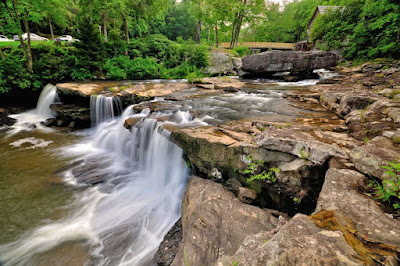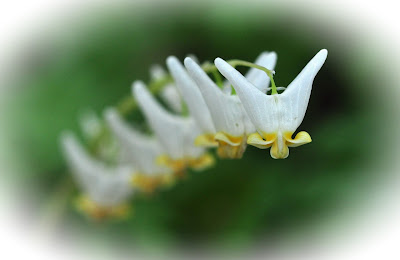View from the Rocks at the End of Stairs
For their first shot of the falls and the mill, most people traditionally take the stairs behind the lodge down to the pond and shoot from the rocks at the end of the stairs. From this pov both the falls and mill are close and produce good composition.View from Sewell Road Opposite the Dam
Another traditional point of view is to walk down Sewell Road along Glade Creak on the opposite side of the parking lot and shoot back toward the mill and falls from the road. Good compositions along the road are possible until reaching the end of the pond and the small dam that forms it. From this pov, the falls and the mill adopt an eye pleasing alignment. With a little zoom added, the photo below shows the scene on the road directly above the dam.View from the Dam below Sewell Road
Shots from these two traditional povs nearly always produce good results giving the falls and mill a serene look. However, I have experimented with three other povs that interject a different, perhaps more dynamic mood. For instance, to capitalize on reflections from the old swimming pool, I prefer to take a few shots at pool level. To get down to pool level, I take a short trail that begins at Sewell Road right above the dam and leads down to the dam abutment below the road. Safe set-ups can be made on the end of the dam or just behind it. The resulting pov offers better reflections of the pool and interesting views of the stone retaining wall below Sewell Road. The example photograph shows the scene from this location.View from the Lip of the Falls of Glade Creek
After shooting from pool level, I usually climb back up to Sewell Road and walk about half-way up it. Right at the rim of the falls, there’s a short trail from the road leading down to the lip of the falls. It’s not a precarious position and offers a pov that profiles the falls. The grist mill is partially obscured, but I don’t think this takes away anything from a photo taken here. Below is an example of the scene from this pov.View from the Large Rock in Glade Creek
The last set-up I’d like to mention is taken from atop the large rock that sits in the middle of Glade Creek and appears in the upper right of the photo above. In my opinion setting-up on this rock yields a good pov because stream action in Glade Creek and the mill are highlighted. Images from this pov are dynamic and attention grabbing.The mill and falls at Babcock State Park look good from just about any pov. These five spots are just suggestions. There are many other fine locations such as on the grass on the parking lot side of the Glade Creek and down at creek level on this side. Furthermore, when Catawba Rhododendrons are blooming, povs including them are going to make good photographs, too. So relax and enjoy photographing Babcock. The Park will almost certainly reward your efforts.
For more about the mill at Babcock see this blog entry Five Facts about the Mill at Babcock.































